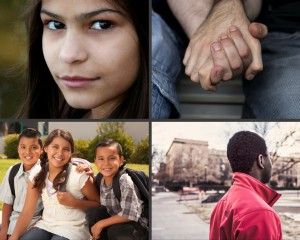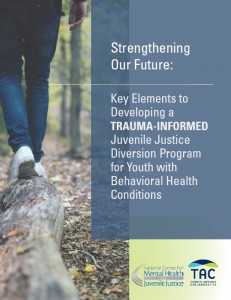This collection of Briefs written by experts invited to the NCTSN Trauma-Informed Juvenile Justice Roundtable, address topics essential to creating trauma-informed Juvenile Justice Systems. These Briefs are intended to elevate the discussion of key elements that intersect with trauma and are critical to raising the standard of care for children and families involved with the juvenile justice system.
In Trauma-Informed Juvenile Justice Roundtable: Current Issues and New Directions in Creating Trauma-Informed Juvenile Justice Systems (2013) (PDF), Carly B. Dierkhising, Susan Ko, and Jane Halladay Goldman, staff at the National Center for Child Traumatic Stress, discuss the Juvenile Justice Roundtable event, describe the current issues and essential elements of a trauma-informed JJ system, and outline possible new directions for the future.
In Trauma-Informed Assessment and Intervention (2013) (PDF) , Patricia Kerig, Professor at the University of Utah, discusses how trauma-informed screening and assessment and evidence-based treatments play integral roles in supporting traumatized youth, explores the challenges of implementing and sustaining these practices, and highlights practice examples for integrating them into a justice setting.
In The Role of Family Engagement in Creating Trauma-Informed Juvenile Justice Systems (2013) (PDF) , Liane Rozzell, founder of Families and Allies of Virginia Youth, discusses the importance of partnering with families, explores strategies for doing so, and emphasizes ways that justice settings expand their outreach to supportive caregivers by broadening their definition of family.
In Cross-System Collaboration (2013) (PDF) , Macon Stewart, faculty at the Center for Juvenile Justice Reform (CJJR), outlines practice examples for continuity of care and collaboration across systems, a vital activity for youth involved in multiple service systems, drawing from the CJJR’s Crossover Youth Practice Model.
In Trauma and the Environment of Care in Juvenile Institutions (2013) (PDF) , Sue Burrell, staff attorney at the Youth Law Center, outlines specific areas to target in order to effectively implement this essential element, including creating a safe environment, protecting against re-traumatization, and behavior management.
In Racial Disparities in the Juvenile Justice System: A Legacy of Trauma (2013) (PDF) , Clinton Lacey, Deputy Commissioner of the New York City Department of Probation, outlines the historical context of racial disparities and highlights how systems can move forward to reduce these racial disparities, including by framing the issue so that practical and pro-active discussion can move beyond assigning blame.




 A critical element of the juvenile justice reform narrative in the past decade has been our elevated understanding of the role that trauma plays in the experiences of young people - particularly those involved with the juvenile justice and child welfare systems. With traumatic events and victimization affecting millions of youth each year, childhood trauma has genuinely become a pressing public health issue.
A critical element of the juvenile justice reform narrative in the past decade has been our elevated understanding of the role that trauma plays in the experiences of young people - particularly those involved with the juvenile justice and child welfare systems. With traumatic events and victimization affecting millions of youth each year, childhood trauma has genuinely become a pressing public health issue. (NCMHJJ).
(NCMHJJ).  Every week Reclaiming Futures rounds up the latest news on juvenile justice reform, adolescent substance use treatment, and teen mental health.
Every week Reclaiming Futures rounds up the latest news on juvenile justice reform, adolescent substance use treatment, and teen mental health. 
 erty such as homelessness, physical and sexual abuse, violence, witnessing shootings, unsafe school conditions, and familial behavioral health issues. Three Compton School district teachers are named for the prosecution alleging that their requests to provide youth with the appropriate behavioral health services were ignored by the district. For those of us that work in the juvenile justice or behavioral health fields these stories seem all too common. Decades of research and practice have shown that trauma has profound negative effects on an individual’s overall health (e.g., neurological, biological, psychological, social). One of the more well-known studies, which is being used to support this lawsuit, is the
erty such as homelessness, physical and sexual abuse, violence, witnessing shootings, unsafe school conditions, and familial behavioral health issues. Three Compton School district teachers are named for the prosecution alleging that their requests to provide youth with the appropriate behavioral health services were ignored by the district. For those of us that work in the juvenile justice or behavioral health fields these stories seem all too common. Decades of research and practice have shown that trauma has profound negative effects on an individual’s overall health (e.g., neurological, biological, psychological, social). One of the more well-known studies, which is being used to support this lawsuit, is the  The
The 
 A
A 
 And this is it, folks, the end of our countdown! We've already shared the
And this is it, folks, the end of our countdown! We've already shared the  We've counted down the top
We've counted down the top  Continuing our countdown of the top juvenile justice blog posts of 2012, here are numbers 16-20:
Continuing our countdown of the top juvenile justice blog posts of 2012, here are numbers 16-20: This has been quite a year for our juvenile justice blog. Not only has readership more than doubled (thank you!) but we've partnered with a number of great organizations and journalists to provide you with more frequent analysis, research and ideas for reform.
This has been quite a year for our juvenile justice blog. Not only has readership more than doubled (thank you!) but we've partnered with a number of great organizations and journalists to provide you with more frequent analysis, research and ideas for reform. Children are naturally curious and may have questions about the violence they see on TV and hear about in the news. Research shows that kids want to talk with parents and caring adults about tough issues - including violence - and that those who have early conversations are more likely to continue to turn to adults as they grow older. But, it can be difficult to talk about violence with kids, so we have compiled a list of resources for parents and youth workers:
Children are naturally curious and may have questions about the violence they see on TV and hear about in the news. Research shows that kids want to talk with parents and caring adults about tough issues - including violence - and that those who have early conversations are more likely to continue to turn to adults as they grow older. But, it can be difficult to talk about violence with kids, so we have compiled a list of resources for parents and youth workers: